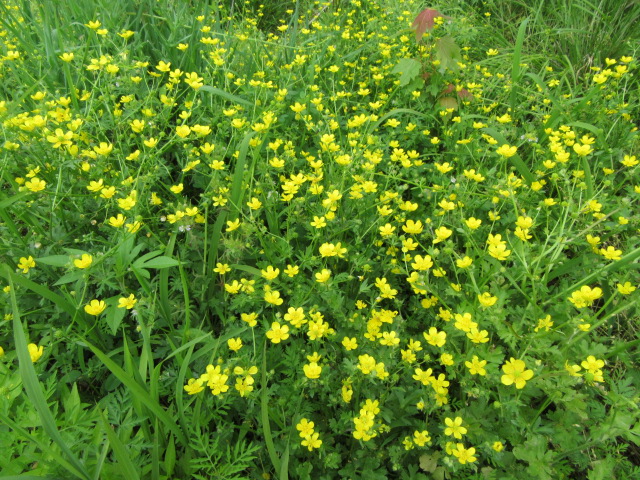
Clematis terniflora (Autumn Clematis) on 9-6-18, #503-7.
Ranunculaceae Juss.
ra-nun-kew-LAY-see-ee
OR
ra-nun-kew-LAY-see-eye
The plant family Ranunculaceae was named and described by Antoine Laurent de Jussieu in Genera Plantarum in 1789.
As of 12-23-23 when this page was last updated, Plants of the World Online lists 51 accepted genera in this family commonly referred to as the buttercup or crowfoot family.
There are some members of this family I have trouble identifying because several species in the genera look A LOT alike… You can click on the plant’s name under the photos to take you to the pages of the species I have identified or grown.
For more information about this family of plants, please click on the links below. The links take you directly to the information about the family. I am going to add photos at some point…
PLANTS OF THE WORLD ONLINE
FLORA OF NORTH AMERICA
WIKIPEDIA
BRITANNICA

Anemone virginiana var. virginiana (Tall Thimbleweed) on 6-16-21, #801-2.
I ran across this Anemone virginiana var. virginiana (Tall Thimbleweed) along the trail next to my farm on June 16 in 2021. Plants of the species found in Missouri are identifiable as Anemone virginiana var. virginiana. The other two varieties are found mainly in the northeast and Canada but some of their ranges overlap…
<<<<+>>>>

Aquilegia viridiflora ‘Chocolate Soldier’ flower on 4-18-12, #87-6.
I brought this Aquilegia virdiflora ‘Chocolate Soldier’ home from Lowe’s in the spring of 2012 when I lived in Mississippi. It did pretty well but I was expecting the flowers to be larger. I should have brought it with me when I moved back to the family farm in Missouri in 2013…
<<<<+>>>>

Clematis terniflora (Autumn Clematis) on 9-6-18, #503-5.
Clematis terniflora (Autumn Clematis) has made its home on the fence along the front pasture of the farm. I noticed one has also started on the fence along the road. As long as it stays put without trying to take over it is OK… The flowers are always teaming with life. Several states have it listed as an invasive species… Sweet Autumn Virginsbower is another common name.
<<<<+>>>>

Delphinium ajacis ? (Giant Larkspur) behind the den of the mansion in Mississippi on 4-15-12, #86-53.
I think the packet of seeds I planted that was labeled “Larkspur” when I lived in Mississippi and plants I bought from a local greenhouse that said “Delphinium Mix” were Delphinium ajacis (Giant Larkspur). Delphinium ajacis and D. consolida are both hard to tell apart. Both species were previously in the Consolida genus (among others). Consolida species were considered annuals (or self-seeding annuals) while Delphinium species were perennials Phylogenetic testing showed that Consolida is an annual clade nested within the Delphinium genus. So, Consolida species were moved to the Delphinium genus but many websites still use the genus name Consolida…
<<<<+>>>>

Enemion biternatum (False Rue Anemone) on 4-27-20, #692-25.
I found this little Enemion biternatum (False Rue Anemone) growing next to a tree in a friend’s secluded woods in 2020. Never know what you will run across if you look close.
<<<<+>>>>

Ranunculus abortivus (Small-Flowered Buttercup) on 4-4-20, #683-36.
There are several species of Ranunculus growing on the farm that are very difficult to tell apart. I identified a few including this Ranunculus abortivus (Small-Flowered Buttercup) in 2020. Common names include Small-Flowered Buttercup, Littleleaf Buttercup, Kidneyleaf Buttercup, Kidneyleaf Crowfoot, Small-Flowered Crowfoot, and possibly others.
<<<<+>>>>

Ranunculus fascicularis (Early Buttercup) on 5-28-15, #264-11.
I think this small colony of Ranunculus turned out to be Ranunculus fascicularis (Early Buttercup). I only have one photo of this one and the other taken in 2021 is kind of “iffy”… Common names include Early Buttercup, Prairie Buttercup, Early Crowfoot, Tufted Buttercup, and possibly others. Ummm… I returned this page to a draft because it could be R. sardous. There were two colonies that were “iffy” that I recently discovered was R. sardous…
<<<<+>>>>

Ranunculus hispidus (Bristly Buttercup) on 5-17-18, #443-75.
I finally think I properly identified this species as Ranunculus hispidus (Bristly Buttercup) in 2021… It is funny how members on iNaturalist are not so enthused to agree when you add an observation for a species that is difficult. Like me, they would rather meet them in person. There were other photos on this page, but they turned out to be R. sardous…
<<<<+>>>>

Ranunculus parviflorus (Smallflower Buttercup, etc.) on 5-24-22, #883-11.
I finally identified several colonies as Ranunculus parviflorus (Smallflower Buttercup, etc.) in 2022. Other common names include Small-Flowered Buttercup, Stickseed Crowfoot, and possibly others. This one starts as a clump of leaves then becomes a mass of tangled stems and small flowers. The fruits really tell the tale when it comes to identifying Ranunculus species.
<<<<+>>>>

Ranunculus sardous (Hairy Buttercup) on 5-24-22, #883-14. This photo was taken of a colony in front of the pond bank on the farm in Pettis County, Missouri.
I discovered several colonies on the farm were Raununculus sardous (Hairy Buttercup) in 2022. I thought they were other species, but when I got down to the nitty-gritty of identifying Ranunculus, I found the error of my thinking. I had previously dismissed R. sardous as a possibility until a friend’s pasture was COVERED. If you see an overgrazed pasture covered with yellow flowers, it is possibly this species. Once I came to the realization the plants on my friend’s pasture were R. sardous, I had a closer look at several colonies on the farm here and was shocked to find they were also R. sardous. That’s when I learned about using the fruits to make a positive ID. It wasn’t as complicated as I thought. GEEZ!!!
That’s all I have experience with for the plant family Ranunculaceae. I still have a few colonies of Ranunculus to correctly identify…